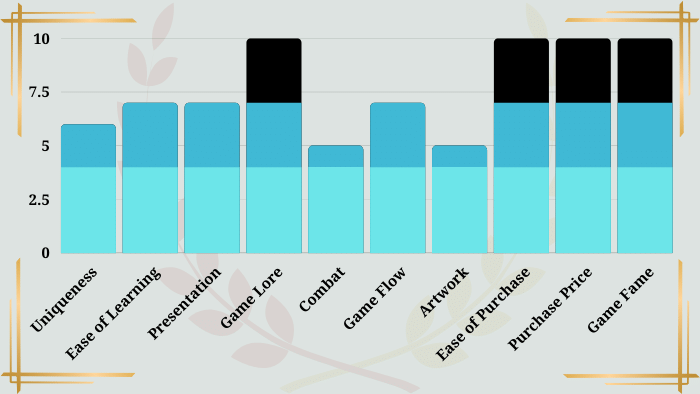Home > TTRPG Reviews
Call of Cthulhu RPG
This Call of Cthulhu RPG review is part of my “Best Tabletop RPGs of All Time” article. If you want to check out more TTRPGs and see how other top-tier tabletop RPGs are ranked, visit that page.
My Review – 77 / 100

Call of Cthulhu is a TTRPG based on stories written by one of the most celebrated horror fiction writers of all time: H.P. Lovecraft. Cthulhu is a deity of chaos worshipped by cultists in many of H.P. Lovecraft’s stories. If you aren’t familiar with books like the “Necromonicon,” I highly recommend you add it to your list.
You can still play Call of Cthulhu RPG without a working knowledge of the stories from which they are derived. However, if you are familiar with even some of the short stories written by H.P Lovecraft, you’ll almost certainly enjoy playing Call of Cthulhu substantially more.
Uniqueness of Call of Cthulhu RPG: (6/10)
The most unique part of Call of Cthulhu RPG is the “sanity system.” Basically, the horrors of the mythos are so tremendous that upon experiencing anything to do with the otherworldly pieces of the game, your character might go insane. The sanity system tracks your character’s sanity “hit points,” in a sense.
When your character experiences something ghastly or born of chaos in any sense, you have to make a sanity check. As you fail checks (which will happen from time to time), your character becomes weaker to the psychic/ mental traumas inherent in a universe with which your character fundamentally can’t fully contend. It’s pretty interesting to watch a character slowly go insane as they brush up against the horrors of Cthulhu multiple times.
Another feature I like in Call of Cthulhu RPG is that when your character succeeds at anything , there’s a chance for your character improve at that specific task. This means that characters get better by doing, which is a system that I love.
One huge downside of the game is that when it comes to skill checks, you really need to be good at math. There are scenarios where you need to half values, then fifth them again. Why? Why is that in the game at all? This is such a great game that I was surprised to find such a frustrating mechanic.
Ease of Learning the Game: (7/10)
As with rolling skill checks, determining character stats is easy if you’re good at multiplying numbers in your head, quickly. Many people aren’t, which really bogs down the game. Overall, the numbers aren’t that bad though, as most of the weird math problems are found in character generation and some occasional skill checks.
Primarily, Call of Cthulhu RPG is a mystery/ investigation game. The investigation process is quite cool, and it’s pretty intuitive for new players. Once characters are created, the game gets a little easier, and so long as there aren’t a lot of skill checks being made, the game is fairly simple to play.
Call of Cthulhu Presentation: (7/10)
I really like this game’s presentation in the core rulebook. The book’s font calls back to early 1900’s in the U.S., while the Cthulhu-like tentacles on important parts of the rulebook makes them stand out, and reminds you of the horrors that await you around nearly every corner. The rulebook is easy to follow from a practicality standpoint.
H.P Lovecraft Lore: (10/10)
As I mentioned, Call ofCthulhu is based on the writings of H.P. Lovecraft. So, the lore of Call of Cthulhu RPG is really the lore of stories contained in the “Necronomicon.”
There’s not better lore for a game’s foundation that can be found anywhere in the world.
Combat in Call of Cthulhu RPG: (5/10)
Combat in Call of Cthulhu RPG features relatively simple numbers. I enjoy that when you’re attacked, your character also attacks back in that same action. There are levels of success when it comes to combat checks, and related damage, which is a little weird the way it’s done, but also kind of cool. When you engage in combat, as with normal skill checks, there will be math, so prepare for that.
Combat in Call of Cthulhu is a simple system with not a lot to it. It’s not something I’d enjoy digging into for more than a few minutes at a time, and not for more than once or twice per gaming session.
It is important to note that Call of Cthulhu RPG is not about fighting the horrors of the H.P. Lovecraft mythos, like you might expect from games like Dungeons and Dragons. Instead, the game is one of discovery and investigation. It’s better to run from fights than to ever try and engage in something that’s very likely to end in your character’s death.
Call of Cthulhu comes with the premise that the monsters you’ll face are far superior to your character in almost every way. Their mere presence is sometimes enough to drive your character insane, so there’s often no point whatsoever in fighting them.
Game “Flow”: (7/10)
The tension of Call of Cthulhu comes from the journey of discovery. As you learn more about what’s happening in the game’s world, ideas flow out from your discoveries, and one set of investigations leads to another. With each new step along the journey, drama heightens.
If you loves mystery games and solving riddles/ puzzles, you’ll probably love Call of Cthulhu. For myself, I don’t enjoy uncovering mysteries enough to make it the premise of an entire RPG campaign. Furthermore, I don’t think I’m alone in that sentiment.
So, I scored this game as well as I could for this section of the game’s review, but I don’t believe pure mystery to make for an optimal game flow. Again though, if you love mysteries, go ahead and give this game another 3 points (to make this section 10/10) and you’ll have a better idea of whether or not Call of Cthulhu is the right game for you.
Artwork: (5/10)
Most of the artwork in Call of Cthulhu comes in a comic book style. I like the artwork a lot and feel it fits the dark, mysterious vibe. That being said, you won’t find the high-end art here that you might be used to seeing in other higher-budget RPGs. Overall, there’s not a lot of standout art in this book that will wow you.
There is terrific – and I mean truly terrific – Cthulhu art all over the internet. Search it for yourself and be amazed. It’s just that the quality of artwork you can find literally anywhere online is (astoundingly) not found in the Call of Cthulhu RPG rulebook.
Ease of Purchase: (10/10)
It’s very easy to purchase Call of Cthulhu RPG at either the Chaosium website, or through online retailers like Amazon.
Price & How Many Books Do You Need to Play: (10/10)
You can purchase the game’s starter set for $25. There are also higher tiers of entry according to how much you like the game and want to invest. The options for purchasing the game make it much easier to give it a try if you or the other players in your gaming group are new to Call of Cthulhu.
Fame & Availability of Supplemental Material: (10/10)
Call of Cthulhu has lots of supplemental material to help inspire an ongoing campaign. Plus, all you have to do is pick up the “Necronomicon” for literally endless ideas.
Call of Cthulhu is one of the easier tabletop RPGs to get going with a new group, for this reason.
Call of Cthulhu is Produced By:







